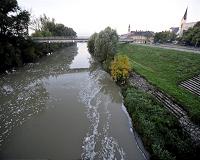 |
The Hague, Netherlands (SPX) Nov 05, 2010 A unique acacia known as a "fertilizer tree" has typically led to a doubling or tripling of maize yields in smallholder agriculture in Zambia and Malawi, according to evidence presented at a conference in the Hague this week. The findings were central to the arguments of agroforestry experts at the conference, who urged decision makers to spread this technology more widely throughout the African nations most vulnerable to climate change and food shortages, and to think differently about more practical ways to solve the problems that are most pressing to smallholder farmers. Speaking today at The Hague Conference on Agriculture, Food Security and Climate Change, Dr. Dennis Garrity, Director General of the World Agroforestry Centre, said that evergreen agriculture-or the integration of fertilizer trees into crop and livestock-holding farms-is rapidly emerging as an affordable and accessible solution to improving production on Africa's farms. "Doubling food production by mid-century, particularly in Africa, will require nonconventional approaches, particularly since so many of the continent's soils are depleted, and farmers are faced with a changing climate," Garrity said. "We need to reinvent agriculture in a sustainable and affordable way, so that it can reduce its emissions of greenhouse gases and be adapted to climate change." Garrity spoke to leading agriculture and climate scientists, policymakers, development experts, and private sector representatives from around the world gathered at The Hague to develop a concrete action plan for linking agriculture-related investments, policies, and measures to transition agriculture to lower carbon-emitting, climate-resilient growth. In a recent article in Food Security, Garrity and co-authors highlighted how evergreen agriculture has already provided benefits to several million farmers in Zambia, Malawi, Niger and Burkina Faso. Fertilizer trees draw nitrogen from the air and transfer it to the soil through their roots and leaf litter, replenishing exhausted soils with rich sources of organic nutrients. The trees bolster nutrient supply, increase food crop yields, and enhance the production of fodder, fuel and timber. These systems also provide additional income to farmers from tree products, while at the same time storing much greater amounts of carbon than other agricultural systems. For example, farmers in Malawi have increased their maize yields by up to 280 percent when the crop is grown under a canopy of one particular fertilizing tree, Faidherbia albida. Unlike most other trees, Faidherbia sheds its leaves during the early rainy season and remains dormant during the crop-growing period. This makes it highly compatible with food crops because it does not compete with them for water, nutrients, or light-only the bare branches of the tree's canopy spread overhead while crops of maize, sorghum, or millets grow to maturity below. The leaves and pods also provide a crucial source of fodder in the dry season for livestock when nearly all other plants have dried up. The trees may continue to provide these cost-free benefits for up to 70 to 100 years. In Niger, there are now more than 4.8 million hectares of millet and sorghum being grown in agroforests that have up to 160 Faidherbia trees on each hectare. The Intergovernmental Panel on Climate Change (IPCC) has already noted that transforming degraded agricultural lands into agroforestry has far greater potential to store carbon than any other managed land use change. Researchers suggest that integrating agroforestry into farming systems on a massive scale would create a vital carbon bank. The IPCC estimates that a billion hectares of developing country farmland is suitable for conversion to carbon agroforestry projects. A broad alliance is now emerging of governments, research institutions, and international and local development partners committed to expanding evergreen agriculture and agroforestry. The International Fund for Agricultural Development, the Alliance for a Green Revolution in Africa, the European Union, the Consultative Group on International Agricultural Research, and the UN Environment Programme are among those interested in developing partnerships to move the evergreen agriculture agenda forward. "We are already working with 18 countries across the African continent to develop national plans for the accelerated implementation of evergreen agriculture," Garrity explained. The next step is to further refine and adapt the technologies to a wider range of smallholder farming systems in diverse agricultural environments, so that millions more farmers can benefit now and for generations to come from such sustainable solutions to their food production challenges. "Evergreen agriculture allows us to glimpse a future of more environmentally-sound farming where much of our annual food crop production occurs under a full canopy of trees," said Garrity.
Share This Article With Planet Earth
Related Links Mofe info on evergreen agriculture World Agroforestry Centre Farming Today - Suppliers and Technology
 Europe taking phosphates out of wash in water clean-up
Europe taking phosphates out of wash in water clean-upBrussels (AFP) Nov 4, 2010 Europe took steps Thursday to ban phosphates from laundry detergents in little over a year in a bid to clean up its rivers, lakes and marine waters. A European Commission proposal said the ban aimed to reduce phosphates found in waste water which, when discharged, can cause algae to grow at the expense of other aquatic life - a phenomenon known as "red tides" or "green tides" that scientist ... read more |
|
| The content herein, unless otherwise known to be public domain, are Copyright 1995-2010 - SpaceDaily. AFP and UPI Wire Stories are copyright Agence France-Presse and United Press International. ESA Portal Reports are copyright European Space Agency. All NASA sourced material is public domain. Additional copyrights may apply in whole or part to other bona fide parties. Advertising does not imply endorsement,agreement or approval of any opinions, statements or information provided by SpaceDaily on any Web page published or hosted by SpaceDaily. Privacy Statement |